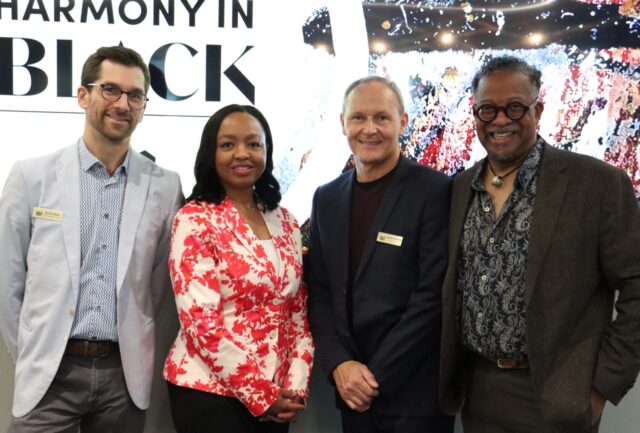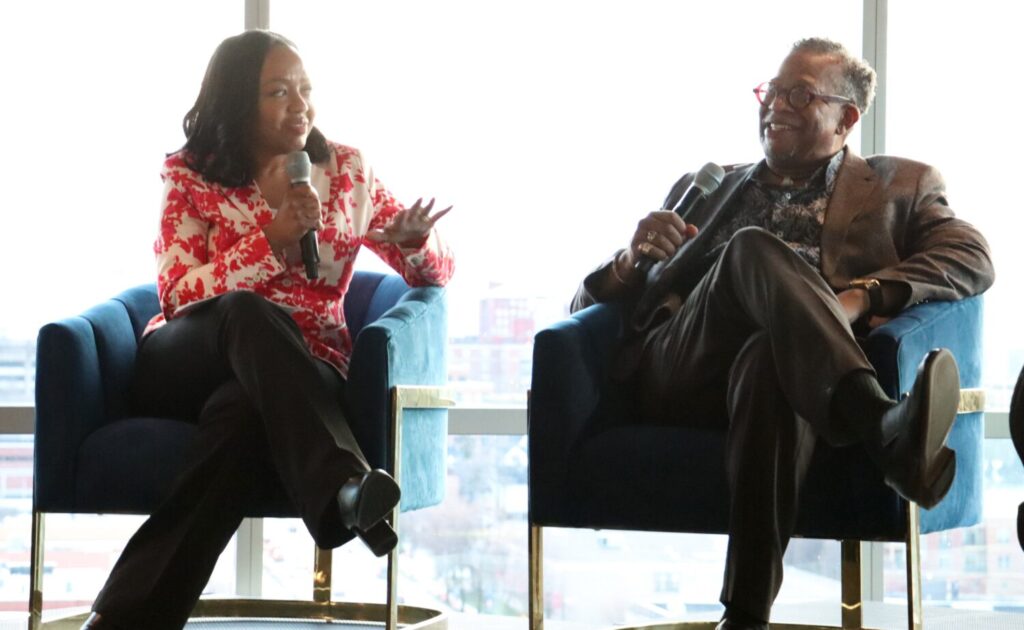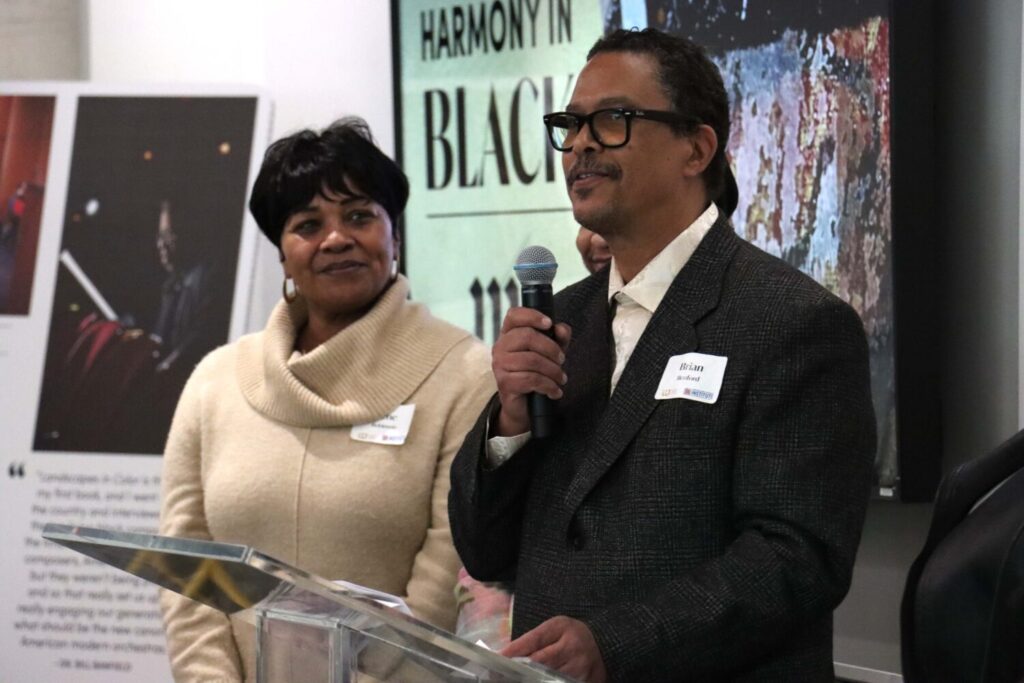
The Wisconsin Chamber Orchestra (WCO) celebrated the release of Harmony in Black, the first album in WCO’s Musical Landscapes in Color initiative, on the evening of March 14. The album features classical compositions from four-time Grammy nominee Patrice Rushen and WCO Composer in Residence Dr. William Banfield. Over the next four years, Musical Landscapes in Color will release four additional albums featuring contemporary composers of color for a total of five albums.
The release party, which was held at The Spark, opened with remarks from American Family Insurance Institute for Corporate and Social Impact’s Social Impact Investment Director Nyra Jordan, WCO CEO Joe Loehnis, UW Odyssey Project Success Coach Brian Benford, and members of this year’s Odyssey cohort. Mayor Satya Rhodes-Conway also made an appearance early in the night.
Harmony in Black features Rushen’s “Mine Eyes Have Seen the Glory” and two compositions from Banfield entitled, “Testimony of Tone, Tune and Time” and “Symphony No. 8.” The album was performed live and recorded in October of 2023, conducted by WCO Musical Director Andrew Sewell and featuring over 60 WCO musicians.
But the different parts that would eventually make up the Musical Landscapes in Color project, which falls under WCO’s Composer Collective series, came together far before Harmony in Black itself came to life. Inspired by Banfield’s book project Musical Landscapes in Color: Conversations with Black American Composers, in which he interviews 41 living Black composers about their work, Banfield and Rushen were already discussing which of those musicians they wanted to feature in an album even before Banfield arrived at WCO in 2021.
In order to do so, the two had originally planned to use existing music, for which they’d need licensing permissions to use. But when Banfield was invited to be WCO’s Composer in Residence, the missing puzzle piece presented itself: the Wisconsin Chamber Orchestra, under Sewell’s direction.
“This has really lined up organically in a wonderful way,” Banfield said. “Here we [were] with a live orchestra that’s committed, with a record label.” Harmony in Black was produced with Albany Records.
Beyond being a living testament to Banfield’s book, the project also fits neatly into WCO’s efforts to increase its relevance to contemporary audiences and strengthen connections with the larger Madison community. Right around the time that Banfield started his residency, WCO was also developing a five-year strategic plan that strives to be “purposeful with diversity” and “expand the accessibility of [WCO’s] work.”

“We had all the right ingredients coming together for a very tangible project that we can do right now, squarely within our goals as an organization [and] within the strategic plan,” Loehnis explained.
Each composition in Harmony in Black honors a different Black historical figure, featuring original audio from Dr. Martin Luther King Jr. and Paul Robeson and recordings of Frederick Douglass’s oration and writings. For Rushen, being able to integrate King’s speeches into her music was seamless: “[His voice] in and of itself has melody, rhythm, tambour. It has all of the elements of what music is,” she said.
And while Harmony in Black shines an important light on Black history, it’s just as much about “pass[ing] on the baton and educat[ing] the next generation” in classical music, Sewell told attendees on Thursday. WCO’s investment in bringing in new listeners is most evident in its collaboration with the UW Odyssey Project, a University of Wisconsin-Madison initiative that empowers low-income adults to pursue their college degrees.
Leading up to the album’s recording and release, Banfield and Rushen spent time with UW Odyssey cohorts to show them what possibilities there are in the current arts landscape, especially for Black creatives. “It was wonderful to me because I’ve never personally imagined seeing Black figures in that space,” Odyssey student Synquar Harston said. “It was a big eye-opener to me to see them in that way.”
And while Harston says that he doesn’t gravitate towards classical music in his everyday listening, he’s gained a new perspective on the genre as a whole from his time with both composers. “I do appreciate the work and dedication that they show and put into their performances,” he explained. “So I do like going to listen to classical music. It’s a story being told in a different way than what we’re used to.”

Rushen and Banfield see themselves as being on the “ground floor” of a new model for contemporary classical music. “Our jobs as artists is to present [audiences] with things that are of a certain caliber for them to be able to feel something,” Rushen explained. “And being in on this particular endeavor with WCO is very special because I think it redefines what our roles are, as composers, as musicians, [and] as artists. I like to say that art can be a reflection of what is, but it’s also the seeds of the possibilities.”
“You can imagine what that means when you have younger people in this generation who can actually see what that means to be a composer and to have a relationship with […] a symphony that wants to make their work relevant to the community they live in and relevant to the generation which allows it to continue,” Banfield added.
As the sun set over Madison and the city slipped into dusk, the audience was treated to three excerpts from Harmony in Black, one from each composition, selected by Sewell. The music was followed by a playful, animated conversation between Banfield, Jordan, Loehnis, and Sewell about the individual pieces and the album’s greater resonance. “We rarely get the chance to talk about the human condition connected to music,” Banfield said.
WCO also announced the five composers who will be part of Musical Landscapes in Color’s second volume: Michael Abels, Valerie Coleman, Xavier Foley, Andre Meyers, and Patrice Rushen.
The recorded performance will take place on October 11, at 7:30 p.m. at the Capitol Theater in the Overture Center for the Arts.



























